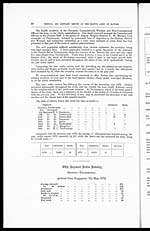Medicine - Institutions > Army health reports and medical documents > Medical and sanitary reports of the native army of Madras > Medical and sanitary report of the native army of Madras for the year 1876
(48) Page 39
Download files
Individual page:
Thumbnail gallery: Grid view | List view

SOUTHERN DISTRICT.
39
The following return shows the rates of sickness, deaths, and invaliding, as
contrasted with previous years:—
| Years. | Stations. | Rate per Cent. of | ||||
| Average Strength Present. | Average Strength. | |||||
| Admissions. | Daily Sick. | All Deaths. | Pensioned. | Sick Leave. | ||
| 1873 | Trichinopoly | 102.42 | 2.73 | .14 | 1.16 | 2.32 |
| 1874 | Do. | 163.48 | 2.77 | 1.73 | 4.76 | 2.88 |
| 1875 | Do. | 81.72 | 2.76 | 1.76 | 4.25 | 4.55 |
| Average | 115.87 | 2.75 | 1.21 | 3.39 | 3.25 | |
| 1876 | Trichinopoly | 73.19 | 2.82 | 2.04 | 2.91 | 2.91 |
Surgeon-Major T. G. Howell was in medical charge during the year and reports
as follows:—
Water-supply obtained from wells only, but of good quality.
Water-supply
Sanitary arrangements. —The sanitary arrangements have been well attended to and no local
cause of disease allowed to remain. The condition of the men’s huts, within the lines, admit
however of improvement.
Sanitary
arrangements
Duty. —The average number of nights per week the men have had in bed have been
havildars 5, naigues 4, and privates 4½.
Duty.
Epidemic. —In the regimental lines sporadic cases of cholera occurred, the disease being
epidemic elsewhere.
Epidemic.
Hospital ventilation. —The ventilation of the hospital is defective, especially when all
the beds are occupied. The accommodation may be considered sufficient under ordinary
circumstances, and hospital tents are always available for the prevention of overcrowding.
Hospital
ventilation.
General conclusions. —The general health of the corps during the past year has, on the
whole, been somewhat better than in the preceding one.
General
conclusions.
Deputy Surgeon-General J. Wilson inspected this corps on the 7th December
1876 and reports as under:—
Sanitary condition of the lines as to cleanliness, ventilation, &c. —The lines are clean and
the streets wide and airy, but the huts themselves are quite unsuitable, the walls being of mud
and the roofs thatched; are also less than the regulated size, and were built merely as tempo-
rary structures five years since, with the understanding that they would be abandoned in a
year. The drainage of the lines is bad as there is no natural slope; there are water channels
cut in the soil, which however, owing to the conformation of the ground, do not carry off water
completely after a fall of rain.
Sanitary
condition of
the lines as
to cleanliness,
ventilation,
&c.
Sanitary condition of latrines, &c. —There are two latrines, which are kept clean by a
conservancy establishment.
Sanitary
condition of
latrines, &c.
Rations. —The sepoys are evidently, from their appearance, insufficiently fed.
Rations.
Water-supply. —The water used for drinking purposes is obtained from wells alone, of which
there are six in the lines. In two of these only the water is pure. The supply has been barely
sufficient this year owing to the absence of rainfall.
Water-
supply.
Hospital. —The hospital is clean but dark and ill-ventilated; there are no ridge ventilators,
which could be easily erected. The building is large enough, but a cheerless structure. The
water-supply is from a well in the compound, and is sufficient and of good quality. The lighting
at night is very defective, being from two old-fashioned oil lamps; it would be a great improve-
ment if kerosine could be substituted.
Hospital.
Principal diseases. —The proportion of fever is large, which I consider is chiefly attribut-
able to the miserable huts in which the sepoys live, and also to a portion of the lines being on
the same level as the adjoining rice-fields.
Principal
diseases.
Set display mode to: Large image | Zoom image | Transcription
Images and transcriptions on this page, including medium image downloads, may be used under the Creative Commons Attribution 4.0 International Licence unless otherwise stated. ![]()
| Permanent URL | https://digital.nls.uk/74991448 |
|---|




